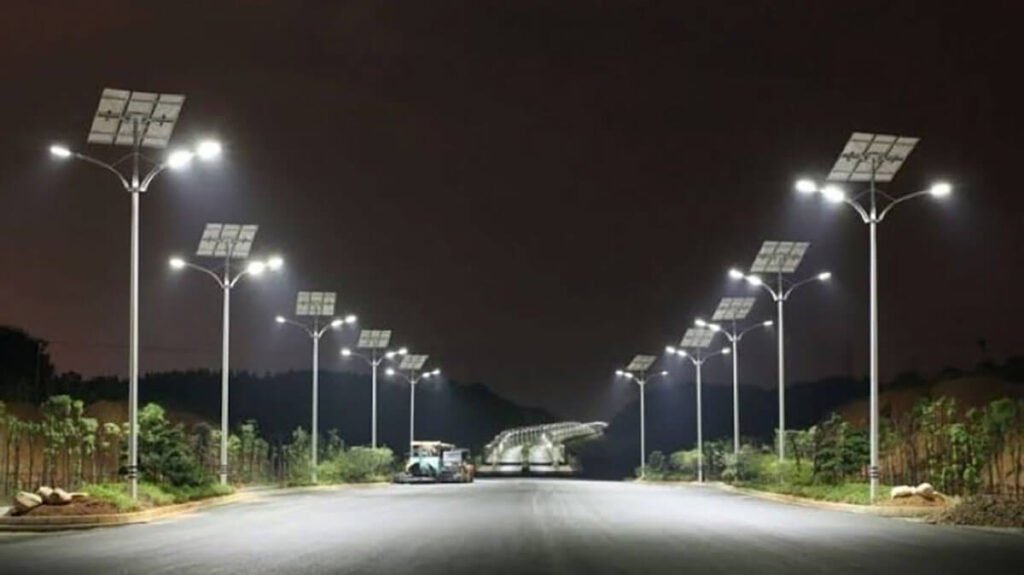Close

REGION 8 (Potaro–Siparuni) – In a major stride toward inclusive development and energy sustainability, the Government of Guyana has successfully installed solar-powered street lights across Mahdia and neighboring hinterland communities. This initiative is reshaping daily life in Region 8 by enhancing public safety, extending economic activity into the evening hours, and demonstrating a commitment to clean energy solutions.
Spearheaded through a partnership involving the Ministry of Public Works, the Office of the Prime Minister, and the Guyana Energy Agency (GEA), this project aligns with national goals to close the development gap between urban and remote areas. The introduction of solar street lighting in Mahdia, Campbelltown, Micobie, and El Paso is a clear signal that the benefits of modern infrastructure are reaching all corners of the country (Guyana Energy Agency, 2024).
These solar-powered lights are helping to deter crime, prevent nighttime accidents, and encourage greater social and commercial activity after dark. “We feel safer now walking at night,” a resident of Campbelltown shared during a recent community meeting facilitated by the Ministry of Amerindian Affairs. Vendors and small business operators also report an uptick in activity as the streets remain active for longer hours.
Environmentally, the solar-powered lights reduce reliance on fossil fuels and the national electricity grid, aligning with the objectives of Guyana’s Low Carbon Development Strategy (LCDS) 2030. They are low-maintenance, cost-effective, and ideal for off-grid hinterland areas. The GEA has confirmed the installation of over 200 solar lights in Region 8 to date, with further expansion planned for even more remote communities in the coming months (Guyana Energy Agency Annual Report, 2024).
This development marks more than just technological progress—it is a symbol of equal opportunity and national unity. As more hinterland communities gain access to sustainable infrastructure, Region 8 stands as a model of how renewable energy can uplift rural populations and reinforce national goals for resilience and inclusion.

The Guyana Project is an independent media platform delivering fact-checked, ground-level reporting on politics, economy, and public life in Guyana. With a focus on transparency and development, we bring unfiltered news and thoughtful analysis to help shape a more informed, forward-looking nation.

Empowering Region 8: Solar Street Lights Illuminate Safer, Greener Communities

Lorem Ipsum is simply dummy text of the printing and typesetting industry. Lorem Ipsum has been the industry’s standard dummy text ever since the 1500s, when an unknown printer took a galley of type and scrambled it to make a type specimen book. It has survived not only five centuries, but also the leap into electronic typesetting, remaining essentially unchanged. It was popularised in the 1960s with the release of Letraset sheets containing Lorem Ipsum passages, and more recently with desktop publishing software like Aldus PageMaker including versions of Lorem Ipsum.
t is a long established fact that a reader will be distracted by the readable content of a page when looking at its layout. The point of using Lorem Ipsum is that it has a more-or-less normal distribution of letters, as opposed to using ‘Content here, content here’, making it look like readable English. Many desktop publishing packages and web page editors now use Lorem Ipsum as their default model text, and a search for ‘lorem ipsum’ will uncover many web sites still in their infancy. Various versions have evolved over the years, sometimes by accident, sometimes on purpose (injected humour and the like).
Contrary to popular belief, Lorem Ipsum is not simply random text. It has roots in a piece of classical Latin literature from 45 BC, making it over 2000 years old. Richard McClintock, a Latin professor at Hampden-Sydney College in Virginia, looked up one of the more obscure Latin words, consectetur, from a Lorem Ipsum passage, and going through the cites of the word in classical literature, discovered the undoubtable source. Lorem Ipsum comes from sections 1.10.32 and 1.10.33 of “de Finibus Bonorum et Malorum” (The Extremes of Good and Evil) by Cicero, written in 45 BC. This book is a treatise on the theory of ethics, very popular during the Renaissance. The first line of Lorem Ipsum, “Lorem ipsum dolor sit amet..”, comes from a line in section 1.10.32.